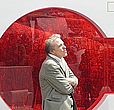Abel Ferrara on shooting films in New York and Italy
Posted on at
The following article was written by Christian Niedan and published on his blog 'Camera in the Sun', on January 3, 2011.
Camera Q&A;: Abel Ferrara on shooting films in New York and Italy
Who: Abel Ferrara is a New York City-based filmmaker who has written and directed several features set/shot in Manhattan. A decade ago, he moved to Rome, Italy, and directed three feature films — including one shot inside Cinecittà studios and another in the city of Naples — then returned to make two documentaries about iconic NYC locales. He is currently planning a NYC-shot film with Ethan Hawke and frequent collaborator, Shanyn Leigh titled The Last Day on Earth. From January 7th-18th, Anthology Film Archives will screen Ferrara’a five most recent 21st century films.
Why did you decide to make films in Italy?
Unlike in Europe, where filmmakers, a lot of their money is from the government — in America, it’s capitalism at it’s finest. In the ’90s, everything was like an independent film situation, and the banks were financing these movies that were made with maybe 3, 4, 5 million dollars — with which we make our films. We control product from beginning to end, which is the key for a filmmaker like me. And at a certain point, that ended, and all these independent companies went out of it. New Line, Miramax, October — there was a bunch of them. They all kind of threw in the towel and became part of the Hollywood studio system and make studio films that way. That’s not the way we make films, and at a certain point we had an opportunity. A lot of our films are financed there in England with foreign money. With Mary, the film was set in Jerusalem and in Rome. And Go Go Tales, we were building a location at Cinecittà, even when we were shooting on location in New York. Italy, before 2007, was kind of a good place for us for financing and making films.
Was shooting Go Go Tales on a Cinecittà studio set a new approach for you?
We worked on a studio before, but to totally build a set, it was great. Because it was all conceived, in real time, to be shot inside a go go court. So, to create that space from scratch was the best. Those are the best carpenters at Cinecittà, and the Italian art — you know, it was my design that [Production Designer] Frankie [DeCurtis] built basically with their guys. You’ve got the whole tradition and history of Italian filmmaking. We’re shooting the same place where Fellini and these guys shot.
These are the best filmmakers in the world. Their pace was our pace. And you do it til you get it right, you know. And we shoot fast anyway. We like shooting fast. It’s a misconception that these guys are slow. It’s not true. We shot Go Go Tales in 20-something days. We shot Mary in 20 days, and shooting in three countries.
Did shooting on a controlled set give things a different feel than, say, the strip club in Fear City?
Fear City was written to be shot in the go go clubs in New York in 1975. And we ended up shooting it in Hollywood [20th Century-Fox] five years later. It was basically the same thing — Fear City was more of a studio film. A lot of money — or enough money — and we were designing and building sets, as opposed to shooting Bad Lieutenant-style. The last shot of Bad Lieutenant, that’s all hidden camera. Different takes, people did different things.
For Napoli Napoli Napoli, why did you use both real prison interviews and fictional narratives?
You know, it’s funny, when you put a camera in front of someone, then all of a sudden you question how real things are. Once the camera enters the equation, everybody’s an actor. You know, just because you’re talking to someone in a documentary situation doesn’t mean the information you’re getting is true. And the same thing, just because you’re making stuff up doesn’t mean it’s fiction. It was something that just seemed like the right way to put together to tell a story — to use all the elements.
Click here to read the rest of the article.
 Abel Ferrara – Official Website
Abel Ferrara – Official Website